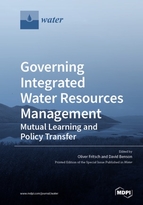Governing Integrated Water Resources Management: Mutual Learning and Policy Transfer
A special issue of Water (ISSN 2073-4441). This special issue belongs to the section "Water Resources Management, Policy and Governance".
Deadline for manuscript submissions: closed (1 April 2019) | Viewed by 61755
Special Issue Editors
Interests: environmental politics and law; water governance; public participation; regulatory and environmental impact assessment and other forms of ex-ante policy appraisal; policy implementation and effectiveness
Interests: EU environmental and energy policy; comparative water governance; public participation in environmental decision-making; circular economy; wastewater pollution remediation technologies; solar PV governance
Special Issue Information
Dear Colleagues,
Integrated Water Resources Management (IWRM) has become a global paradigm for the governance of surface, coastal, and groundwaters. International bodies, such as the United Nations, the Global Water Partnership, and the European Union, have taken the lead to promote IWRM principles, and countries worldwide, both in the Global South and the Global North, have undertaken reforms to implement these principles and to restructure their domestic or regional water governance arrangements. However, the international transfer of IWRM principles raises a number of theoretical, empirical and normative questions. These relate to the causes, process and outcomes of policy transfer in the field of IWRM.
First, why do countries adopt IWRM principles and what mechanisms are in place to motivate and further the adoption of these principles in regional or national contexts? We invite contributions that apply, criticise, extend or revise existing approaches towards norm transfer and international norm adoption and explore them empirically in a water governance context.
Second, how does policy transfer in the field of IWRM take place across borders, levels and scales? We welcome submissions that unpack the process of norm adoption and norm application in the field of water and explore how IWRM principles travel between international organisations and the domestic sphere, between globally and domestically operating non-state actors and regional and national governments, but also between countries and national governments.
Third, what are the impacts of IWRM principles, once implemented, on domestic water governance, water quality and water supply—and how effective is IWRM in addressing critical water issues in specific countries?
This Special Issue invites contributions tackling any of these questions. However, manuscripts which take a comparative perspective and/or make use of theory and concepts are particularly welcome. Submissions may focus on specific aspects of IWRM, such as river basin planning, integration between water related sectors, economic valuation, public participation including gender inclusion, or take a holistic approach.
Dr. Oliver Fritsch
Dr. David Benson
Guest Editors
Manuscript Submission Information
Manuscripts should be submitted online at www.mdpi.com by registering and logging in to this website. Once you are registered, click here to go to the submission form. Manuscripts can be submitted until the deadline. All submissions that pass pre-check are peer-reviewed. Accepted papers will be published continuously in the journal (as soon as accepted) and will be listed together on the special issue website. Research articles, review articles as well as short communications are invited. For planned papers, a title and short abstract (about 100 words) can be sent to the Editorial Office for announcement on this website.
Submitted manuscripts should not have been published previously, nor be under consideration for publication elsewhere (except conference proceedings papers). All manuscripts are thoroughly refereed through a single-blind peer-review process. A guide for authors and other relevant information for submission of manuscripts is available on the Instructions for Authors page. Water is an international peer-reviewed open access semimonthly journal published by MDPI.
Please visit the Instructions for Authors page before submitting a manuscript. The Article Processing Charge (APC) for publication in this open access journal is 2600 CHF (Swiss Francs). Submitted papers should be well formatted and use good English. Authors may use MDPI's English editing service prior to publication or during author revisions.
Keywords
- Integrated Water Resources Management
- IWRM
- governance
- policy transfer
- public participation







